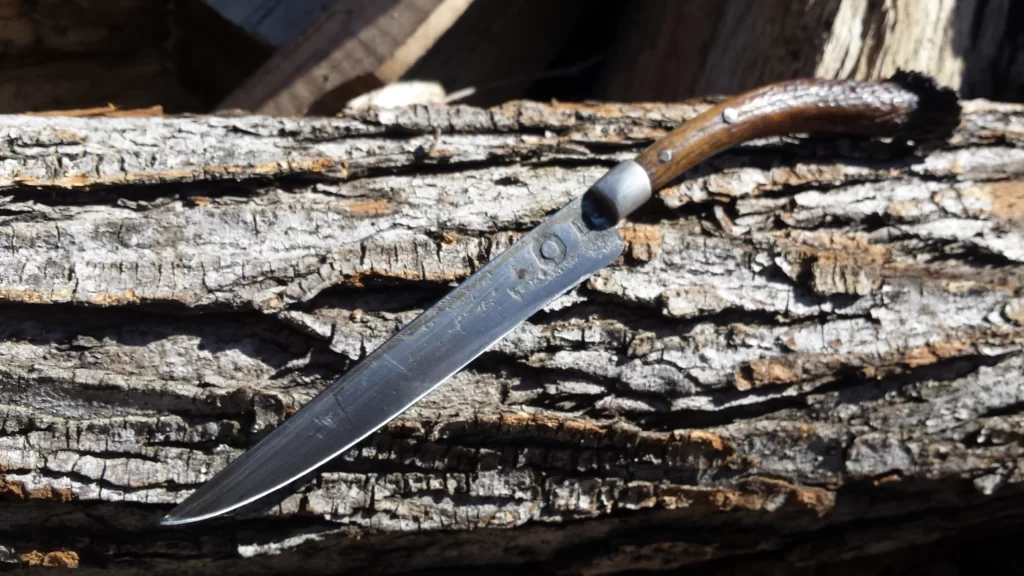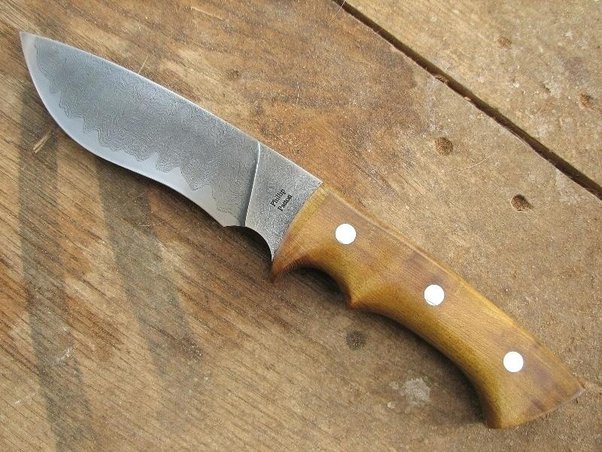Last updated on January 16th, 2024 at 09:38 am
Knives come in many styles for different uses. Many tradesmen and outdoor lovers use the patch knife. Patch knives are different from conventional blades, but what are they?
This tutorial will cover patch knives’ purpose, manufacture, uses, and more. This essay will help patch knife collectors of all levels.
What is a Patch Knife?
A patch knife has a handle and a short, sharp blade. It cleans, maintains, and repairs weapons, especially muzzleloaders. The “patch” in patch knife refers to the muzzleloader cleaning patch. Patch knives cut and shape these patches for proper firearm cleaning and maintenance.
The History of Patch Knives
Patch knives have a long history that predates firearms. Muzzleloaders were popular in colonial America, and patch knives maintained them. Patch knives were perfect for cutting barrel-cleaning patches to size.
Patch knives improved with time. They got more specialised and used new materials for better performance and longevity. Muzzleloaders and black powder shooters still use patch knives.
Features and Characteristics of Patch Knives

Patch knives have different sizes, but they have some similarities. Understanding these factors will help you choose a patch knife.
Blade: Patch knives feature straight, 2–5-inch blades. High-carbon steel blades are sharp and durable.
Handle: Patch knives can have wood, bone, antler, or synthetic handles like G-10 or Micarta. It should be durable and easy to hold.
Tang: The blade’s tang extends into the handle. Patch knives have full or hidden tangs for strength and stability.
Sharpness: A patch knife must be razor-sharp to cut cleaning patches precisely. Performance depends on blade sharpness.
Portable: Patch knives are compact. They fit in pockets and sheaths.
Versatility: Patch knives can be used for more than just cutting and shaping cleaning patches. These multipurpose tools can open packages, carve small objects, prepare food in the outdoors, and even serve as a backup utility knife during outdoor activities.
Tradition and Craftsmanship: Patch knives represent traditional craftsmanship. Patch knives are handcrafted by many knife producers. The craftsmen’s skill is shown in these knives’ elaborate designs and embellishments.
Common Materials Used in Patch Knife Construction

Patch knives are made from many materials for durability, usefulness, and aesthetics. Patch knife materials include:
High-Carbon Steel: Patch knife blades are often made of high-carbon steel due of its sharpness and edge retention. It is durable and cuts well.
Stainless Steel: Patch knife blades also employ stainless steel. It is corrosion-resistant and easy to maintain than high-carbon steel.
Wood: Patch knife handles are made of wood because of its beauty, comfort, and durability. Walnut, rosewood, and birch are popular.
Bone and Antler: Patch knives with bone and antler handles seem rustic. Natural textures and traditional knife-making practises make them popular.
Synthetic Materials: G-10, Micarta, and polymers are durable, water-resistant, and versatile. They function better and appear like natural materials.
Different Types of Patch Knives

Different patch knives suit different purposes and preferences. Common patch knives:
Straight-Bladed Patch Knife: The most common type. Its straight blade and simple handle are sharp.
Folding Patch Knife: A folding patch knife’s blade folds into the handle for secure storage. Hunters and outdoorsmen who value portability like this patch knife.
Multi-Tool Patch Knife: Some patch knives are multifunctional. Screwdrivers, awls, and bottle openers add versatility.
Custom Patch Knives: Many knife producers make bespoke patch knives. These knives are generally custom-made, letting buyers choose the design, handle material, and blade form.
The Importance of Patch Knives in Outdoor Activities

Patch knives are essential in muzzleloader and black powder outdoor sports. Patch knives are crucial for these reasons:
Firearm Maintenance: Muzzleloaders need frequent cleaning and maintenance to perform properly and last. Patch knives cut and shape cleaning patches to keep weapons clean and efficient.
Field Repairs: Firearms can malfunction while hunting or shooting. Patch knives can remove dirt, mend loose parts, and correct minor mechanical difficulties in the field.
Emergency Preparedness: Prepare for emergencies when outside. Emergency patch knives are useful. They can be used to cut ropes, create shelter, or defend yourself.
Campsite Tasks: Patch knives are handy camping tools. Patch knives are handy for cutting meals, sparking fires, and camp maintenance.
Craftsmanship and Tradition: Patch knives represent traditional craftsmanship. These knives’ cultural and historical relevance appeals to collectors. They preserve past traditions and talents.
How to Choose the Right Patch Knife

Choosing a patch knife includes many aspects. Consider these patch knife considerations:
Intended Use: Choose the patch knife’s tasks. This will assist you choose blade length, handle material, and features.
Blade Material: Consider high-carbon steel and stainless steel blade pros and cons. Sharpness, edge retention, and maintenance vary by material.
Handle Comfort: Make sure the patch knife’s handle is comfy. Find a handle with good ergonomics, texture, and size.
Quality and Durability: Look for patch knives created by trusted manufacturers or expert craftsmen who pay attention to detail. A well-made knife lasts and performs well.
Budget: Set a patch knife budget. High-quality blades with superior materials and craftsmanship may cost more, but they’re worth it.
Reviews and Recommendations: Read customer reviews and ask competent people or online groups about certain patch knife models or brands.
Caring for Your Patch Knife

Maintaining a patch knife is crucial. Tips for patch knife longevity and performance:
Cleaning: Rinse your patch knife with warm water and mild soap after each usage. Clean the blade thoroughly. Dry the knife well to avoid rust.
Sharpening: Keep your patch knife sharp for optimal cutting. Use a knife sharpener or stone. Sharpen the blade correctly by following the manufacturer’s recommendations or asking knife aficionados.
Storage: Keep your patch knife dry. Use a sheath or blade cover to prevent damage and store the blade safely.
Oil and Lubrication: To prevent rust, lubricate the blade occasionally. Lubricate folding mechanisms to guarantee smooth functioning.
Avoid Misuse: Use your patch knife properly. Avoid overstressing the blade or handle, which can shatter it.
Questions (FAQs)
Patch knives for hunting?
Hunting with a muzzleloader or black powder weapon is possible with a patch knife. Patch knives can be used for field dressing small game or rudimentary skinning in addition to cutting and shaping cleaning patches.
Patch knives—legal?
Carrying a patch knife depends on local legislation. Patch knives are often legal to carry as tools rather than weapons. Before carrying a patch knife in public or outdoors, it’s important to know local knife carry rules.
Patch knives for bushcraft?
Bushcraft uses a patch knife. Its small size, sharp blade, and adaptability make it ideal for carving wood, making feather sticks, and tinder preparation. Patch knives are meant to cut and shape cleaning patches, hence they may not be as durable as bushcraft blades.
Patch knife sharpening: how often?
How often you sharpen your patch knife depends on its use and tasks. Check and sharpen your knife regularly. Decreased cutting effectiveness, difficulty slicing materials, or blade dullness indicate that your patch knife needs sharpening.
Patch knife handle customization?
Many patch knives allow handle customization. Custom handles may personalise and beautify your knife. If you customise the handle, select sturdy, pleasant materials that maintain the knife’s balance and functionality.
Conclusion
Muzzleloader aficionados, tradesmen, and outdoorsmen need patch knives. Firearm maintenance, outdoor activities, and traditional workmanship require their unique design, adaptability, and historical relevance.
You can choose a patch knife by studying its characteristics, materials, and selection criteria. Maintain your patch knife, follow safety rules, and confidently explore the rich world of patch knives.
